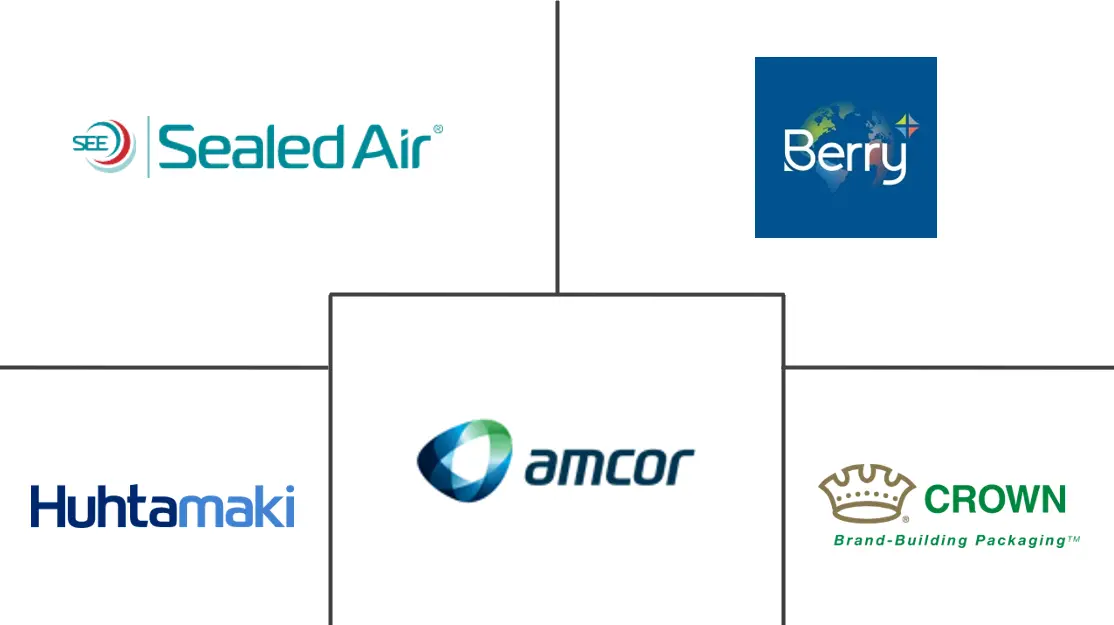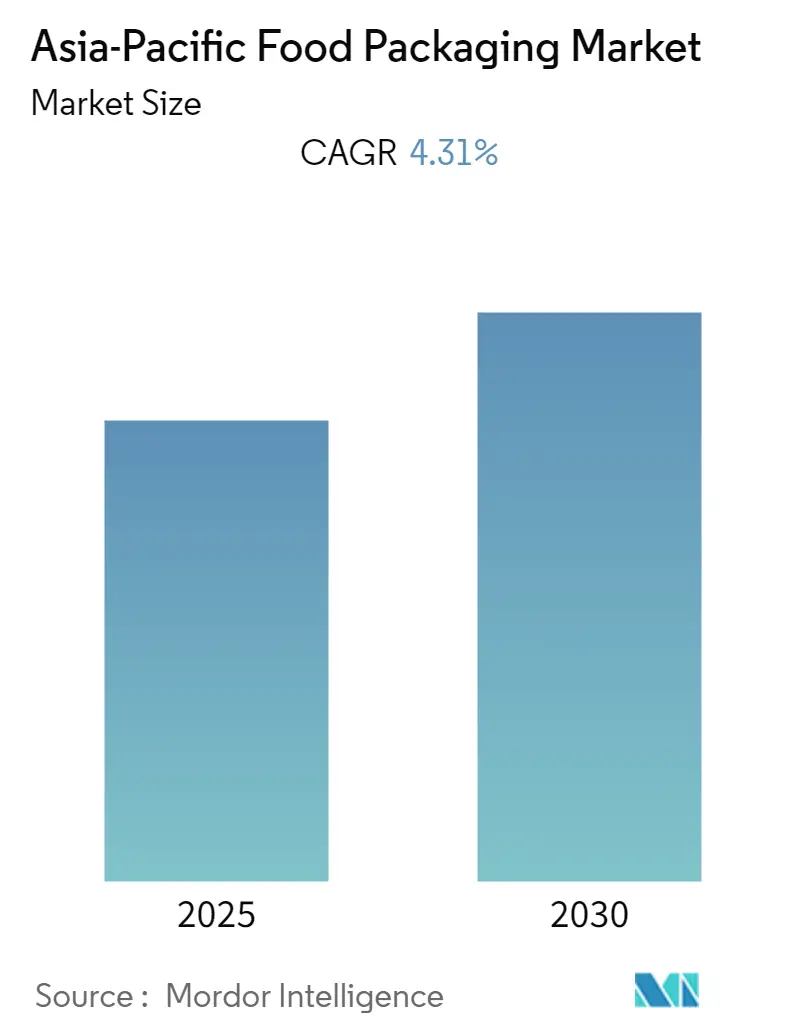
Asia-Pacific Food Packaging Market Analysis by Mordor Intelligence
The Asia-Pacific Food Packaging Market is expected to register a CAGR of 4.31% during the forecast period.
- The increasing exports of fruits and vegetables in Asia-pacific are increasing the growth of the market. The world imports of fruit and vegetables have increased by 17.6%, and imports of fruits and vegetables in the Asia Pacific region increased by 51.6%.
- Moreover, in a country such as India, the growing demand for online food ordering is increasing, which is pushing the usage of packaged food boxes in the food packaging market. For instance, in February 2022, Zomato, one of the prominent food delivery companies, said that the average monthly active food delivery restaurants have grown by 6x and average monthly transacting customers have grown by 13x on Zomato over the past 5 years.
- The changes in the lifestyle of the people and changing food preferences of consumers, along with the increasing population in developing nations, will drive the growth of the market in the forecasted period.
- The growing preference of people for processed food due to the surging working population, rising disposable incomes, and hectic lifestyles, to shifts in population dynamics from rural to urban areas is also driving the food packaging market.
- New packaging technologies, such as active packaging, intelligent packaging, and engineering science, have evolved over the years, which enables the flexible packaging of food products. Companies are adopting eco-friendly packaging by using biodegradable packaging material which can be recycled, renewed, and reused.
- Due to increased dry food procurement fueled by hygiene concerns, the emergence of COVID-19 sparked a demand for canned food across the Asia Pacific area. However, due to a total lockdown and stoppage of manufacturing activities, the industry was unable to fully benefit from the sudden demand surge, which hampered the market's growth in 2020. Furthermore, because health worries are anticipated to persist even after the disease outbreak has subsided, the market is expected to increase steadily in the following years.
Asia-Pacific Food Packaging Market Trends and Insights
Flexible Packaging is Expected to Drive the Market Growth.
- According to IBEF, the Indian food and grocery market is the world's sixth-largest, with retail contributing 70% of the sales. The Indian food processing industry accounted for 32% of the country's total food market, one of the largest industries in India, ranked fifth in terms of production, consumption, export, and expected growth.
- Flexible packaging industry growth in India is primarily driven by the food and pharmaceutical packaging sectors. The enormous and increasing Indian middle class, as well as the country's growing organized retail sector, are driving flexible packaging industry growth. The increasing expansion of exports, which necessitates superior packaging standards for the worldwide market, is another reason that has boosted the packaging business significantly. Flexible plastic packaging reigns supreme in India's packaging business.
- In recent years, typical rigid packaging customers have been seen shifting to flexible packaging. The key reason for this, according to industry sources, is that flexible packaging is aesthetically pleasing, cost-effective, and durable. One of the primary factors contributing to the expansion of flexible packaging in India is consumer preference for convenient packaging and packaged items in reasonable quantities in laminates.
- According to the Flexible Packaging Association, flexible packaging is mostly used for food, accounting for more than 60% of the overall market. Because it was able to incorporate new solutions for the many packaging issues it faced, the flexible packaging industry is experiencing robust growth.
- Beyond convenience, other factors impacting the flexible packaging choice for meat, poultry, and seafood in the food business include sustainability, transparency, food safety, and food waste reduction. Companies are becoming more interested in recyclable and recycled-content flexible packaging solutions due to a number of causes. For this, options such as formable paper, which has great barrier qualities, is suited for lunchmeat and portion packs, and uses up to 80% less plastic, are gaining favor.
- Innovations in most countries, such as through research, retain plastic usage for sustainable food packaging. For instance, in December 2021, a team of scientists from Nanyang Technological University in Singapore (NTU Singapore) and Harvard T.H. Chan School of Public Health in the United States developed a biodegradable, sustainable food packaging material that kills microbes that are harmful to humans. Fresh fruit's shelf life could be extended by two to three days.
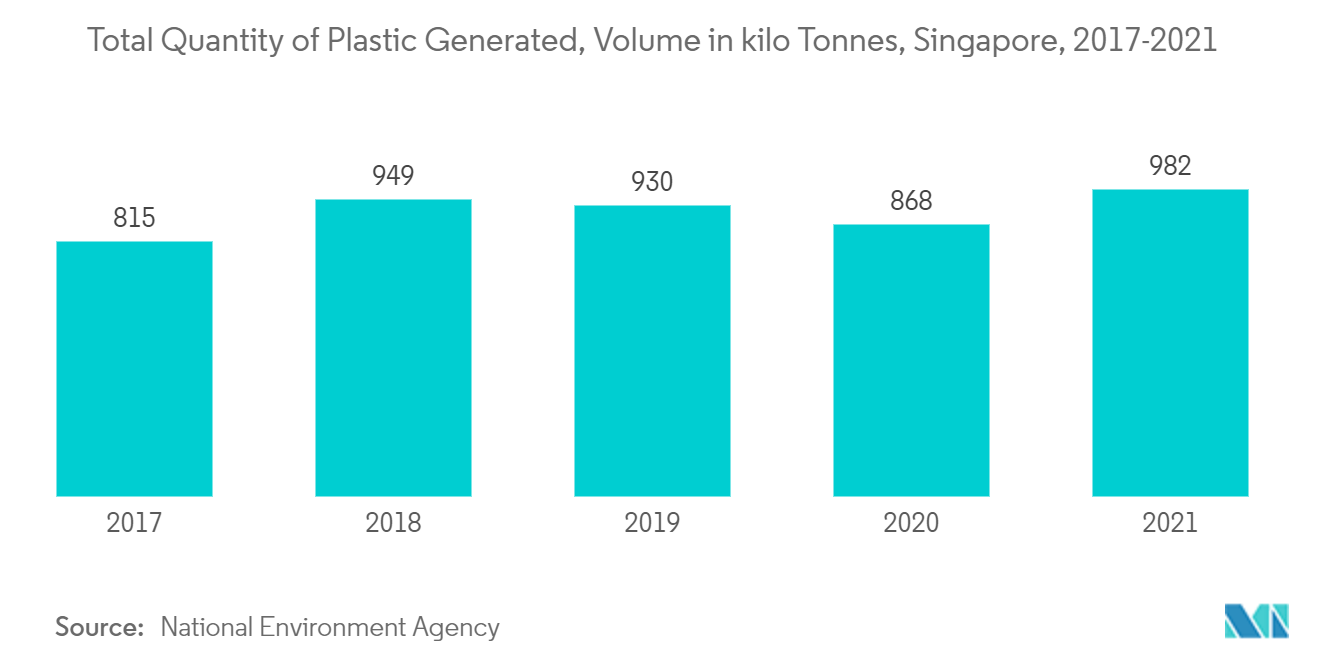
India is Expected to Grow at the Major Rate
- Online retail revenue growth accounts due to economic materials adopted in packaging. Moreover, e-food enterprises may meet rising market needs by taking a holistic approach to food packaging. The optimal mix of high-performance primary and secondary packaging will preserve food quality and integrity while maintaining the proper temperature inside the package, whether hot or cold. Taking a more comprehensive approach to packaging will also aid in improving sustainability.
- Increasing per capita income, rising health consciousness, and changing lifestyle patterns are the key drivers of the flexible packaging market in the country. In addition, the country has a plentiful supply of raw materials for the manufacture of plastic, metal, and paper packaging.
- The India Packaging Market is estimated to reach USD 204.81 billion by 2025, with a CAGR of 26.7 percent from 2020 to 2025, according to the Packaging Industry Association of India. Packaging is one of India's fastest-growing businesses, growing at a rate of 22-25 percent per year, and the country is quickly becoming a preferred hub for the packaging industry, where processed foods, hard and soft drinks, fruit, and marine products are significant sectors in the packaging market.
- Growing competition and government-imposed package regulations for quality, quantity, and price labeling, together with a demand for simple and convenient packaging, have aided in the use of flexible packaging in India. For instance, India, Vietnam, and the Philippines are considering secondary and tertiary packaging-related regulatory measures, with India proposing the most.
- Furthermore, the growth of international trade in packaging material and machinery has been enabled by increased global trade and India's WTO commitment to rationalize tariffs and lower trade barriers, which has provided manufacturers with the machinery needed to innovate and offer enhanced packaging.
- There has been an increase in the number of small pack sizes that are easily consumable in food packaging. "Tabekiri" packets cater to the growing needs of single-person households looking to consume tiny amounts of a range of products.
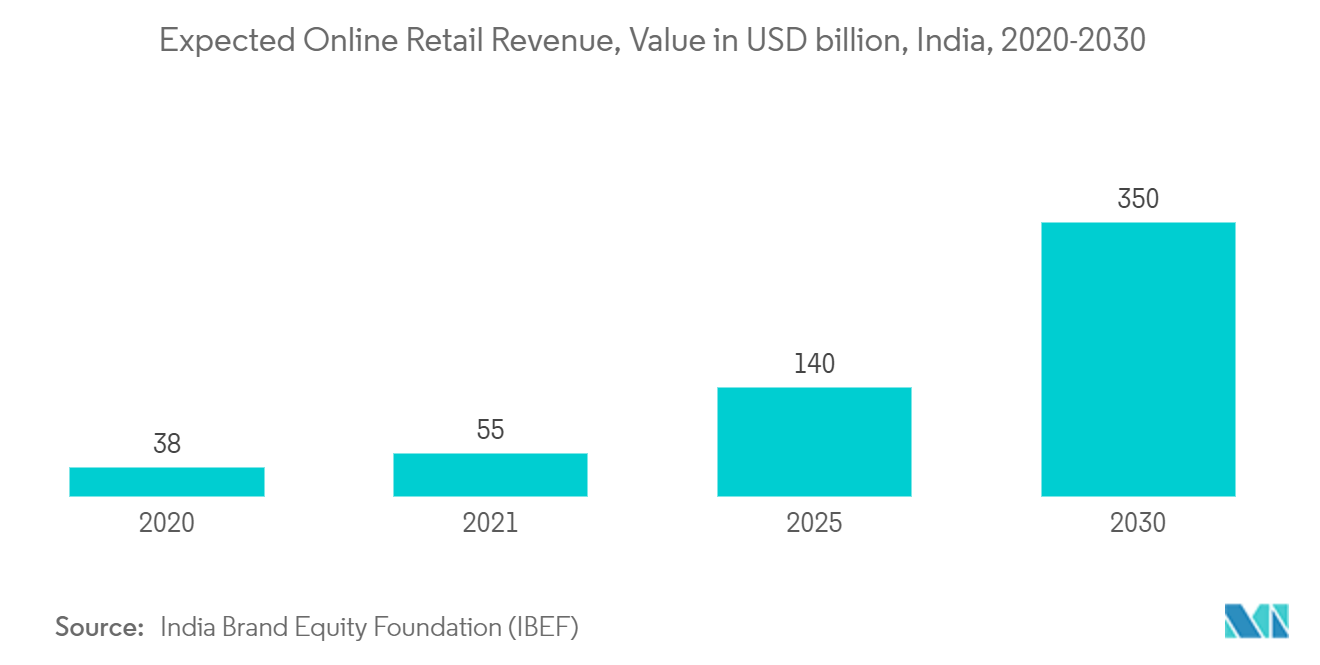
Competitive Landscape
The Asia-Pacific food packaging is a fragmented market. Companies are attempting to enhance their market share and revenue by offering significant product customization. In order to fulfill increasing government criteria, they are working to replace old materials with biodegradable ones. The industry is highly competitive due to the existence of multiple firms.
- January 2022 - Amcor, one of the prominent leaders in developing and producing responsible packaging solutions, launched a new platform for paper-based packaging products: AmFiber. AmFiber innovations aim to redefine the capabilities of traditional paper packaging, providing a wider range of features and functional benefits to meet the changing needs of consumers.
- February 2022 - Aligned with its Twentyby30 program objectives to improve the circular economy, Crown Holdings Inc. announced its commitment to work with industry partners to achieve ambitious new global recycling rates goals for aluminum beverage cans. Designed to be completed by 2030, the targets focus on the inherent recyclability of metal to advance Crown's sustainability efforts and commitments to foster a more responsible industry.
Asia-Pacific Food Packaging Industry Leaders
Sealed Air Corporation
Berry Global Inc.
Huhtamaki Group
Amcor plc
Crown Holdings Inc.
- *Disclaimer: Major Players sorted in no particular order
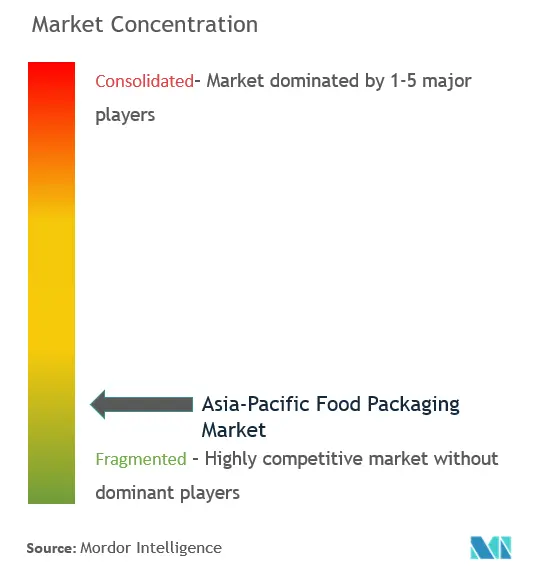
Recent Industry Developments
- March 2022 - The Food Safety and Standards Authority India (FSSAI) has issued new, stricter standards to govern the use of recycled plastic for food packaging after facing pushback from a group of concerned scientific experts, which was designed as a positive move toward more efficient management of the country's massive plastic waste.
- January 2022 - The SIG Group introduced in China the combibloc ECOPLUS, a carton packaging without an aluminum layer. Instead, the aseptic or sterilized packaging expert uses a patented barrier lining that protects liquid products such as milk and juices while significantly reducing its client's carbon footprint.
Asia-Pacific Food Packaging Market Report Scope
Food packaging plays an essential role in preserving and transporting food items to their desired location without affecting the taste or quality. It protects the contents from toxins and moisture, prevents the food products from spillage, and tampering, and helps retain their shape and quality. The Asia-Pacific food packaging market is segmented by material type, product type, end-user type, and country.
| Plastic | Rigid |
| Flexible | |
| Paper and Paperboard | |
| Metal | |
| Glass |
| Bottles and Containers |
| Cartons and Pouches |
| Cans |
| Films and Wraps |
| Caps and Closures |
| Other Product Types |
| Fruits and Vegetables |
| Meat and Poultry |
| Dairy Products |
| Bakery and Confectionery |
| Other end-users |
| China |
| India |
| Japan |
| South Korea |
| Indonesia |
| Thailand |
| Rest of APAC |
| By Material Type | Plastic | Rigid |
| Flexible | ||
| Paper and Paperboard | ||
| Metal | ||
| Glass | ||
| By Product Type | Bottles and Containers | |
| Cartons and Pouches | ||
| Cans | ||
| Films and Wraps | ||
| Caps and Closures | ||
| Other Product Types | ||
| By End-user Type | Fruits and Vegetables | |
| Meat and Poultry | ||
| Dairy Products | ||
| Bakery and Confectionery | ||
| Other end-users | ||
| By Country | China | |
| India | ||
| Japan | ||
| South Korea | ||
| Indonesia | ||
| Thailand | ||
| Rest of APAC |
Key Questions Answered in the Report
What is the current Asia-Pacific Food Packaging Market size?
The Asia-Pacific Food Packaging Market is projected to register a CAGR of 4.31% during the forecast period (2025-2030)
Who are the key players in Asia-Pacific Food Packaging Market?
Sealed Air Corporation, Berry Global Inc., Huhtamaki Group, Amcor plc and Crown Holdings Inc. are the major companies operating in the Asia-Pacific Food Packaging Market.
What years does this Asia-Pacific Food Packaging Market cover?
The report covers the Asia-Pacific Food Packaging Market historical market size for years: 2019, 2020, 2021, 2022, 2023 and 2024. The report also forecasts the Asia-Pacific Food Packaging Market size for years: 2025, 2026, 2027, 2028, 2029 and 2030.
Page last updated on:
Asia-Pacific Food Packaging Market Report
Statistics for the 2025 Asia-Pacific Food Packaging market share, size and revenue growth rate, created by Mordor Intelligence™ Industry Reports. Asia-Pacific Food Packaging analysis includes a market forecast outlook for 2025 to 2030 and historical overview. Get a sample of this industry analysis as a free report PDF download.
